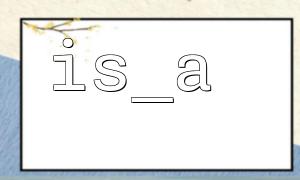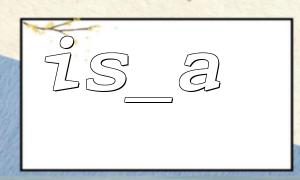In PHP, the is_a function is used to determine whether an object is an instance of a specified class, or whether it is inherited from that class. Its basic usage is as follows:
is_a(object $object, string $class_name, bool $allow_string = false): bool
Here, the third parameter $allow_string is a Boolean value that specifies whether to allow strings of incoming class names to be allowed to replace objects. If the setting is incorrect, the judgment result may be inaccurate.
$object : The object or class name string to be checked.
$class_name : The class name to be judged.
$allow_string (default is false ): Whether to allow $object to be a string (class name), not an object.
When $allow_string is false , is_a will return false if the string is passed in, not an object.
When $allow_string is true , the passed $object can be a class name string. At this time, is_a determines whether the class is a subclass of $class_name or the same class.
Suppose there is the following code:
class ParentClass {}
class ChildClass extends ParentClass {}
$obj = new ChildClass();
// Incorrectly set the third parameter totrue,But the object is passed
$result = is_a($obj, 'ParentClass', true);
var_dump($result);
Here, although $obj is an instance of ChildClass , ChildClass inherits from ParentClass , because the third parameter is true , is_a treats $obj as a string class name, resulting in an exception in the judgment. The result may not be the expected true .
If you are sure that the object is passed in, you should set the third parameter to false or omit it:
$result = is_a($obj, 'ParentClass');
or:
$result = is_a($obj, 'ParentClass', false);
When you pass in a class name string, not an object, you should use the third parameter to true :
$className = 'ChildClass';
$result = is_a($className, 'ParentClass', true);
In this way, is_a will determine whether ChildClass inherits from ParentClass .
class ParentClass {}
class ChildClass extends ParentClass {}
$obj = new ChildClass();
// Use correctly,Don't pass the third parameter or pass itfalse
if (is_a($obj, 'ParentClass')) {
echo "The object isParentClassor an instance of its subclass。";
}
// Error demonstration,The third parameter istrueTime-pass object
if (is_a($obj, 'ParentClass', true)) {
echo "This will not output correctly,因为The third parameter istrueTime-pass object会导致判断不准确。";
}
// Correct demonstration,The third parameter istrueTime-passing class name string
$className = 'ChildClass';
if (is_a($className, 'ParentClass', true)) {
echo "ChildClassyesParentClassSubclasses of。";
}
In actual projects, it is usually recommended to use the instanceof operator to judge object instances:
if ($obj instanceof ParentClass) {
echo "The object isParentClassor an instance of its subclass。";
}
instanceof will not have the ambiguity of the third parameter, which is more intuitive and safe.
When using is_a , make sure that the third parameter $allow_string is set reasonably according to the type of the passed parameter.
If the object is passed in, it is recommended not to pass the third parameter or pass false .
If the class name string is passed in, the third parameter must be set to true .
It is best to use instanceof in the code to judge the object type to avoid misuse is_a .
Through the above methods, the problem of inaccurate judgment results of is_a function can be effectively avoided and the correctness of program logic can be ensured.
// Access Exampleurl
$url = "https://m66.net/example-path";
echo "<a href=\"$url\">点击这里Access Example</a>";














